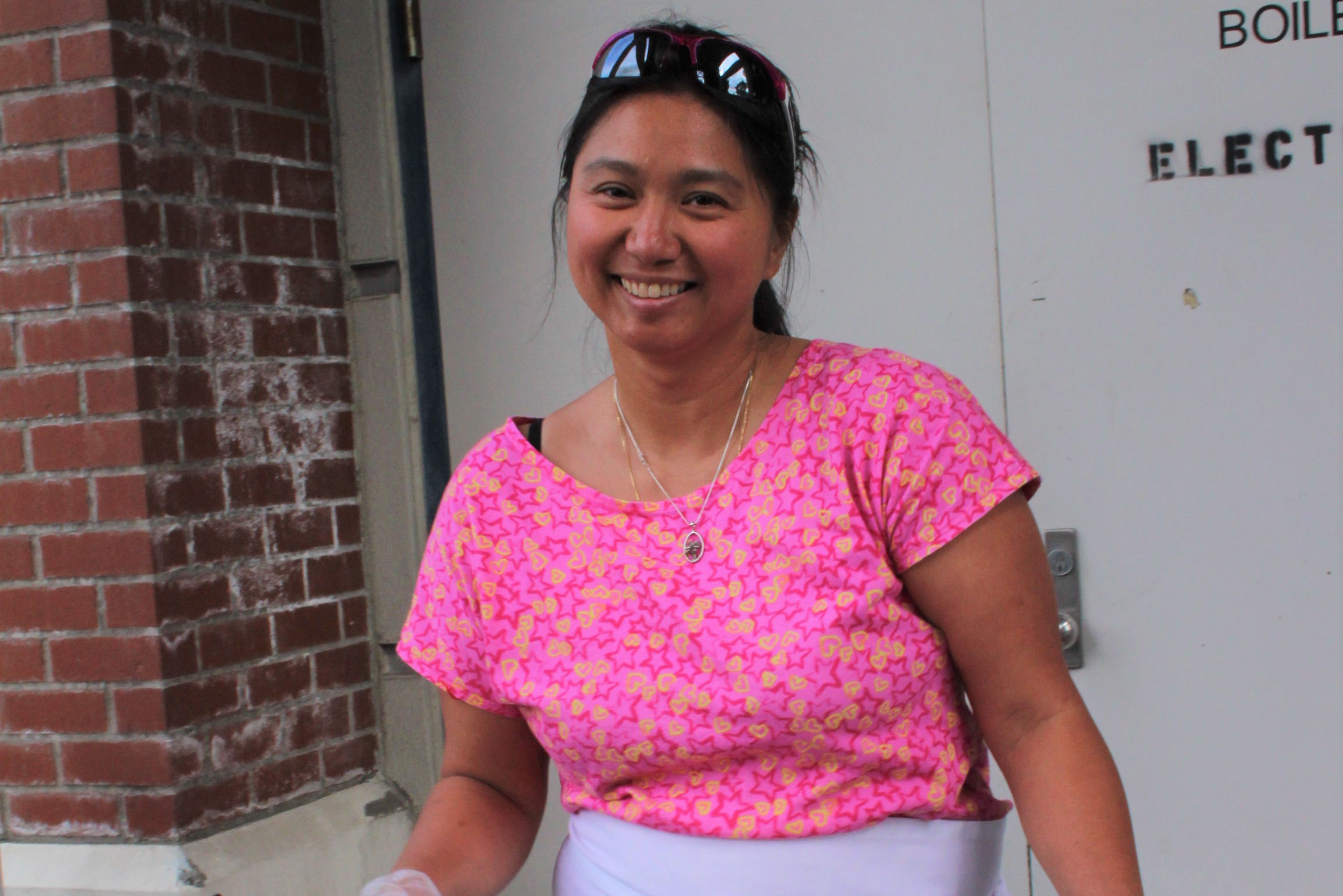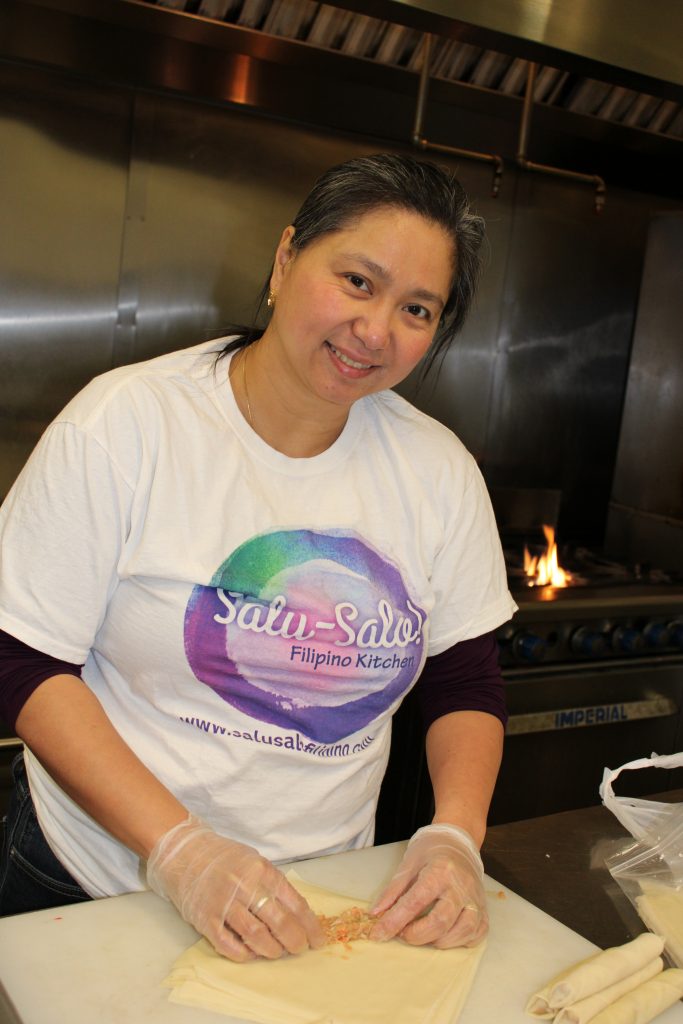Rosario “Chato” Carver:
Owner, Salu-Salo! Filipino Kitchen

“If I don’t know a cuisine, I want to learn it so I can teach you.”
Chato is a Seattle business owner and a collaborator with Project Feast since 2013

Rosario “Chato” Carver
Rosario “Chato” Carver picks up handfuls of shredded vegetables – a mix of sweet potatoes, cabbage, carrots, jicama, bean sprouts and chayote – and rolls them tight into tidy lumpia bundles as she talks through her catering lineup for the week. On this rainy winter day, she will make more than 200 plates of her clients’ lunchtime favorites: sisig (pork and tofu options), brown chicken adobo, sides of rice and pancit (rice noodles) – plus a special order of picadillo and arroz a la cubana with fried plantains. And there are dozens and dozens of lumpia to roll.
In her busy seasons, Chato caters private dinners for groups as small as 10 and events that feed more than 700. “Big or small, I do them all,” she says. “I have to strike when the iron is hot.”
Chato started her Salu-Salo! Filipino Kitchen business in Seattle in 2014, but she’s been cooking all her life. Growing up in Quezon City, in metro Manila, Chato learned kitchen skills early from her mother, a caterer who did cooking demonstrations on TV and was renowned for her delicate tarts and Christmas fruitcake. “I can’t eat other fruitcake because I always compare it to my mom’s!” Chato says. Her seven siblings all have culinary careers, and Chato worked in her family’s businesses and had her own bakeshop in the Philippines. “I had no choice. I always had cooking experience,” she says. “And just like my mom, I have no specialty. I like to make different things.”
BEFORE MOVING TO THE UNITED STATES, Chato enrolled in a cooking school with classically French-trained instructors. There’s a key difference between Filipino and French cooking techniques, she explains: “In Filipino food, we always start with garlic. The French never start with garlic. They start with onions.” Her teachers recognized Chato’s depth of cooking experience. “They said I should be teaching the classes!” she says. “I did it for the credentials, but no one ever asked me for credentials once I got here. I just started cooking.”
When Chato moved to Seattle in 2002, her plan was to eventually go to New York because her cooking school had recommended her for a job. “But I never got out there,” she says. “I got married.”
In 2013, Chato was teaching cooking classes in the Greenbridge community of White Center when her name was mentioned to Veena Prasad, founder and then-executive director of Project Feast, which was in its first year and launching a catering program. “They needed somebody who already knew how to cook,” Chato says. “That’s how they raised funds, from catering gigs, and I helped them get started.”
Chato eventually taught a wide range of cooking classes for Project Feast. “I taught Filipino food, I taught Vietnamese food,” she says. “If I don’t know a cuisine, I want to learn it so I can teach you. That’s pretty much my modus.”
She was quick to pick up recipes from the students and collaborators who brought culinary expertise from around the world into the Project Feast catering teams. “I learned Burmese food and Iraqi food,” Chato says. “Because Project Feast has so many people from different cultures involved, there’s always something new. Even if you’ve already learned tamales from one lady, another lady comes in who makes a different kind.”
Through much of 2016, Chato and Veena worked together on the Project Feast catering program, sharing the revenue and raising the profile for both Salu-Salo! and Project Feast within the Seattle community. “That was a deep partnership,” Veena remembers. And as the Project Feast apprenticeship program took off in 2017 and 2018, Chato arranged for students to visit her commercial kitchen space and tour food-truck operations. “That was so important for the students,” Veena says. “It gave them some perspective on their goals for themselves.”
Salu-Salo! was shaped by the collaboration, too. “I do a lot of the dishes I learned from Project Feast in my own catering gigs,” Chato says. “And if Project Feast cannot do a catering job, they’ll refer the client to me.”
Most of her clients request Filipino food, but she loves getting orders for Italian, Vietnamese and other cuisines. “But after years of pushing other foods, I’m back to pancit, adobo, lumpia because that’s what people want,” she says. Salu-Salo! is a family effort: Her husband, John, joined her in the business after a concierge career that spanned more than 20 years at Seattle’s Sorrento Hotel and Parc Condominium, and their teen son, Andrew, pitches in, too. “He knows how to roll lumpia better than his dad,” Chato says.
She encourages clients to branch out and try her white adobo – a coconut milk-lemongrass style that is traditional in the Bicol region, where her mother is from. “That’s what I like eating,” she says. “For adobo, we have so many different kinds, but people are familiar with the brown adobo and don’t want to be adventurous.”
CHATO’S 2020 CATERING SCHEDULE was already filling up by mid-March, when the coronavirus pandemic hit Washington state hard. After the stay-home order took effect, much of Chato’s business evaporated. Now, her plans for a new food truck are also on hold, and she’ll need to find a new commercial kitchen space because the Seattle commissary where she and other business owners have rented for years is shutting down. “I’m kitchenless,” she says.
But Chato is not giving up on Salu-Salo! “I cannot close. I have customers lined up for next year’s weddings,” she says. When it’s safe for her catering and food-truck business to operate, Chato promises: “I’ll be back. I’m not throwing in the towel.”
She’s been using some of her time during the pandemic to experiment in her home kitchen. This summer, she made pan de sal, traditional Filipino bread rolls, incorporating ube, the vibrant purple yam that has turned many baked goods into Instagram stars. Chato later learned her sister in the Philippines was experimenting, too. “Same bread, same day,” she says.
IT’S BEEN A FEW YEARS since Chato last traveled home to the Philippines, where her nieces are carrying the family’s culinary legacy into the next generation. Her mother, now in her 90s, no longer cooks but can still help a little in the kitchen. On one visit, Chato found notebooks of her mother’s recipes. “I just scanned and scanned,” she says. “She has beautiful handwriting. I didn’t want the recipes to disappear.”
Despite living half a world away, Chato is close to her family and often calls on her older sister, Roxanne, for guidance when she makes their mother’s recipes. “She’s really the one who inherited the cooking skills and talent from our mom,” Chato says. “She’s my go-to research reference.”
One family favorite is a roasted boneless chicken stuffed with sticky rice, chestnuts, shiitakes, lotus seeds, salted eggs, raisins and sausage – a Chinese-inspired dish that Chato’s mother sometimes prepared for Christmas dinners. Last December, Chato’s niece asked for the recipe so she could make the chicken on Christmas Eve at her home in California. The memory made Chato a little homesick, so she cooked the same recipe to share with Filipino friends at an after-Christmas party in Seattle. And Roxanne made the same dish for New Year’s Eve dinner, with their mother, in Quezon City. The family, thousands of miles apart, came together during the holidays over the treasured dish, Chato says: “Within seven days, we all had the same chicken for dinner!”
– Interview and writing by Denise Clifton, Tandemvines Media
Filipino Chicken Adobo
Ingredients
- 2 1/2 lbs chicken pieces (bone-in thighs and/or drumsticks work best)
- 3 to 4 cloves garlic, smashed
- 1 cup white vinegar
- 1/4 tsp black peppercorns, cracked
- 1 bay leaf
- 1/3 cup soy sauce
- 3/4 tsp salt to taste
- vegetable oil for sautéing
- 3 to 4 medium potatoes, cut in 1 in. pieces
- enough water to cover
Instructions
- 1. Combine all ingredients in a deep stainless steel sauce pan.
- 2. Bring to a boil over medium heat, then reduce heat to medium low.
- 3. Cover and simmer for about 30 minutes or until the meat is very tender.
- 4. Gently turn the meat occasionally during the course of cooking.
- 5. Remove the meat from the sauce and pan-fry in a little oil until browned on all sides.
- 6. Transfer to a serving platter or bowl and cover with sauce. Serve with steamed rice.
Lumpia Shanghai
Ingredients
- 2 lbs ground pork (can substitute with ground chicken)
- 1/2 lb shrimp
- 1/2 cup green onions
- 1 cup carrots, finely shredded
- 1 cup onion, finely chopped
- 2 tsp soy sauce
- 1 raw egg
- 1 tsp salt
- 2 tsp ground black pepper
- Lumpia wrapper (Spring roll skin)
- Oil for deep frying
Instructions
- 1. Mix all the ingredients with the pork starting with the onion, carrots, green onions, salt, soy sauce, ground pepper, and raw egg.
- 2. Wrap about 1 ½ tbsp. meat in the lumpia wrapper.
- 3. Fry the lumpia until golden brown, making sure that all the sides are cooked evenly.
- Serve with sweet and sour sauce.
Pancit Guisado
Ingredients
- 1 tbsp cooking oil
- 1/2 lb pork or chicken, sliced into thin strips
- 2 cloves garlic, minced
- 1 onion, sliced
- 1 large carrot, julienned
- 1 red bell pepper, julienned
- patis (fish sauce), salt, pepper and soy sauce to taste
- 2 cups chicken broth or water
- 1 cup cabbage leaves, cut into thin strips
- 1/2 lb pancit bihon (thin rice noodles)
- wedges of lemon or calamansi, for garnish
Instructions
- 1. Rinse pancit bihon with tap water. Drain. Set aside.
- 2. Heat oil in a large skillet. Stir-fry pork or chicken slices until no longer pink in color.
- 3. Add garlic and onion. Sauté for a few minutes until soft.
- 4. Season with patis, salt, pepper and soy sauce to taste.
- 5. Add julienne carrots and red bell peppers. Stir-fry for a few minutes.
- 6. Add chicken broth or water. Correct the seasoning.
- 7. Heat until boiling and add the drained pancit bihon.
- 8. Let it simmer and stir to loosen the noodles (separate noodles by using a fork and a ladle)
- 9. Add a little more water or broth if you notice that the pan is almost dry and the noodles are not cooked through. You may also add soy sauce if you find the taste bland.
- 10. Add cabbage leaves (do not overcook) and then turn off the heat. Mix well.
- Serve with lemon wedges or calamansi. Enjoy!



